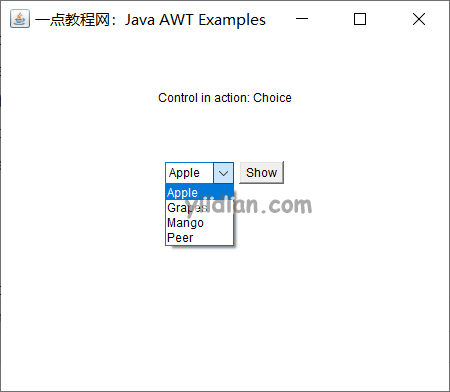AWT Choice类
1 什么是Java AWT Choice
Choice选择控件用于显示选择的弹出菜单。所选选项显示在菜单顶部。
2 Java AWT Choice的语法
public class Choice
extends Component
implements ItemSelectable, Accessible
3 Java AWT Choice的构造方法
| 构造方法 | 描述 |
|---|---|
| Choice() | 创建一个新的选择菜单。 |
4 Java AWT Choice的方法
| 方法 | 描述 |
|---|---|
| void add(String item) | 将项目添加到此选择菜单。 |
| void addItem(String item) | 自 Java 2 平台 v1.1 起已过时。 |
| void addItemListener(ItemListener l) | 添加指定的项目侦听器以从此选择菜单接收项目事件。 |
| void addNotify() | 创建选择的对等点。 |
| int countItems() | 已弃用。从 JDK 1.1 版开始,由 getItemCount() 取代。 |
| AccessibleContext getAccessibleContext() | 获取与此 Choice 关联的 AccessibleContext。 |
| String getItem(int index) | 获取此选项菜单中指定索引处的字符串。 |
| int getItemCount() | 返回此选项菜单中的项目数。 |
| ItemListener[] getItemListeners() | 返回在此选择上注册的所有项目侦听器的数组。 |
| <T extends EventListener> T[] getListeners(Class<T> listenerType) | 返回当前在此选择上注册为 FooListeners 的所有对象的数组。 |
| int getSelectedIndex() | 返回当前选定项的索引。 |
| String getSelectedItem() | 以字符串形式获取当前选择的表示形式。 |
| Object[] getSelectedObjects() | 返回一个包含当前所选项目的数组(长度为 1)。 |
| void insert(String item, int index) | 将项目插入到此选择的指定位置。 |
| protected String paramString() | 返回表示此选择菜单状态的字符串。 |
| protected void processEvent(AWTEvent e) | 处理此选择上的事件。 |
| protected void processItemEvent(ItemEvent e) | 通过将它们分派到任何已注册的 ItemListener 对象来处理在此 Choice 菜单上发生的项目事件。 |
| void remove(int position) | 从指定位置的选择菜单中删除一个项目。 |
| void remove(String item) | 从“选择”菜单中删除第一次出现的项目。 |
| void removeAll() | 从选择菜单中删除所有项目。 |
| void removeItemListener(ItemListener l) | 移除指定的项目侦听器,使其不再从此选择菜单接收项目事件。 |
| void select(int pos) | 将此选项菜单中的选定项目设置为指定位置的项目。 |
| void select(String str) | 将此选项菜单中的选定项目设置为名称等于指定字符串的项目。 |
5 Java AWT Choice的例子
让我们看一个简单的Java AWT Choice类示例。
package com.yiidian;
import java.awt.*;
import java.awt.event.ActionEvent;
import java.awt.event.ActionListener;
import java.awt.event.WindowAdapter;
import java.awt.event.WindowEvent;
public class AwtControlDemo {
private Frame mainFrame;
private Label headerLabel;
private Label statusLabel;
private Panel controlPanel;
public AwtControlDemo(){
prepareGUI();
}
public static void main(String[] args){
AwtControlDemo awtControlDemo = new AwtControlDemo();
awtControlDemo.showChoiceDemo();
}
private void prepareGUI(){
mainFrame = new Frame("一点教程网:Java AWT Examples");
mainFrame.setSize(400,400);
mainFrame.setLayout(new GridLayout(3, 1));
mainFrame.addWindowListener(new WindowAdapter() {
public void windowClosing(WindowEvent windowEvent){
System.exit(0);
}
});
headerLabel = new Label();
headerLabel.setAlignment(Label.CENTER);
statusLabel = new Label();
statusLabel.setAlignment(Label.CENTER);
statusLabel.setSize(350,100);
controlPanel = new Panel();
controlPanel.setLayout(new FlowLayout());
mainFrame.add(headerLabel);
mainFrame.add(controlPanel);
mainFrame.add(statusLabel);
mainFrame.setVisible(true);
}
private void showChoiceDemo(){
headerLabel.setText("Control in action: Choice");
final Choice fruitChoice = new Choice();
fruitChoice.add("Apple");
fruitChoice.add("Grapes");
fruitChoice.add("Mango");
fruitChoice.add("Peer");
Button showButton = new Button("Show");
showButton.addActionListener(new ActionListener() {
public void actionPerformed(ActionEvent e) {
String data = "Fruit Selected: "
+ fruitChoice.getItem(fruitChoice.getSelectedIndex());
statusLabel.setText(data);
}
});
controlPanel.add(fruitChoice);
controlPanel.add(showButton);
mainFrame.setVisible(true);
}
}
输出结果为:

热门文章
优秀文章


